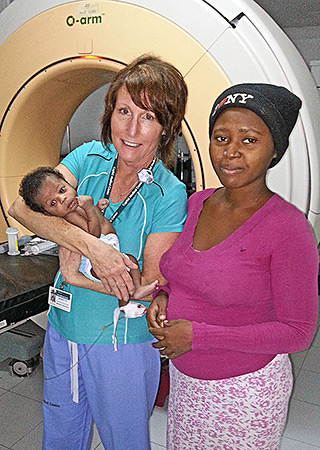Sep. 4, 2013
 I volunteered at Bernard Mevs Hospital in Port-au-Prince, Haiti, as a RAD-AID ASRT Foundation R.T. Fellowship for Developing Countries recipient. My role was to help increase the knowledge of radiation protection at the hospital. Many teachable moments presented themselves throughout my week at the hospital, and I discovered that while medical supplies and resources are limited in Haiti, resiliency and grit are in abundance.
I volunteered at Bernard Mevs Hospital in Port-au-Prince, Haiti, as a RAD-AID ASRT Foundation R.T. Fellowship for Developing Countries recipient. My role was to help increase the knowledge of radiation protection at the hospital. Many teachable moments presented themselves throughout my week at the hospital, and I discovered that while medical supplies and resources are limited in Haiti, resiliency and grit are in abundance.
The Haitian technologists I worked alongside consistently produced quality images. They understood what a good image must look like. However, they repeated a scan if the image was not textbook-perfect. I discussed with them what information needs to be present for the various x-ray exams, and I explained the cumulative properties of radiation with repeated exams.
The Haitian technologists were impeccable in their use of lead shielding for their patients. To add intelligent individuals who wanted to learn more about our craft.
Amid limited resources, the Haitian technologists work creatively. To conserve electricity, the hospital’s power is shut off for about an hour every day at 4 p.m. All CT scans come to a halt. There are no antiseptic wipes. Instead, the staff uses a recycled pop bottle with a bleach water solution and a towel. The portable x-ray machine — the workhorse of their department — goes on a generator. There is no overhead x-ray tube. The x-ray table is a long wooden table with a Plexiglas top. The table is hollow so that the digital radiography reader can be inserted. Upright work is done at a rolling cassette holder attached to a pole.
I left Port-au-Prince with the conviction that technologists work together to produce quality diagnostic images, no matter the situation we find ourselves in. The joy of that goal is contagious and alive in Haiti.
This article was originally published in ASRT Scanner, Vol. 46, No. 6, Page 37. Nancy Keeran, the article's author, is a recipient of 2013 ASRT Foundation travel grant.